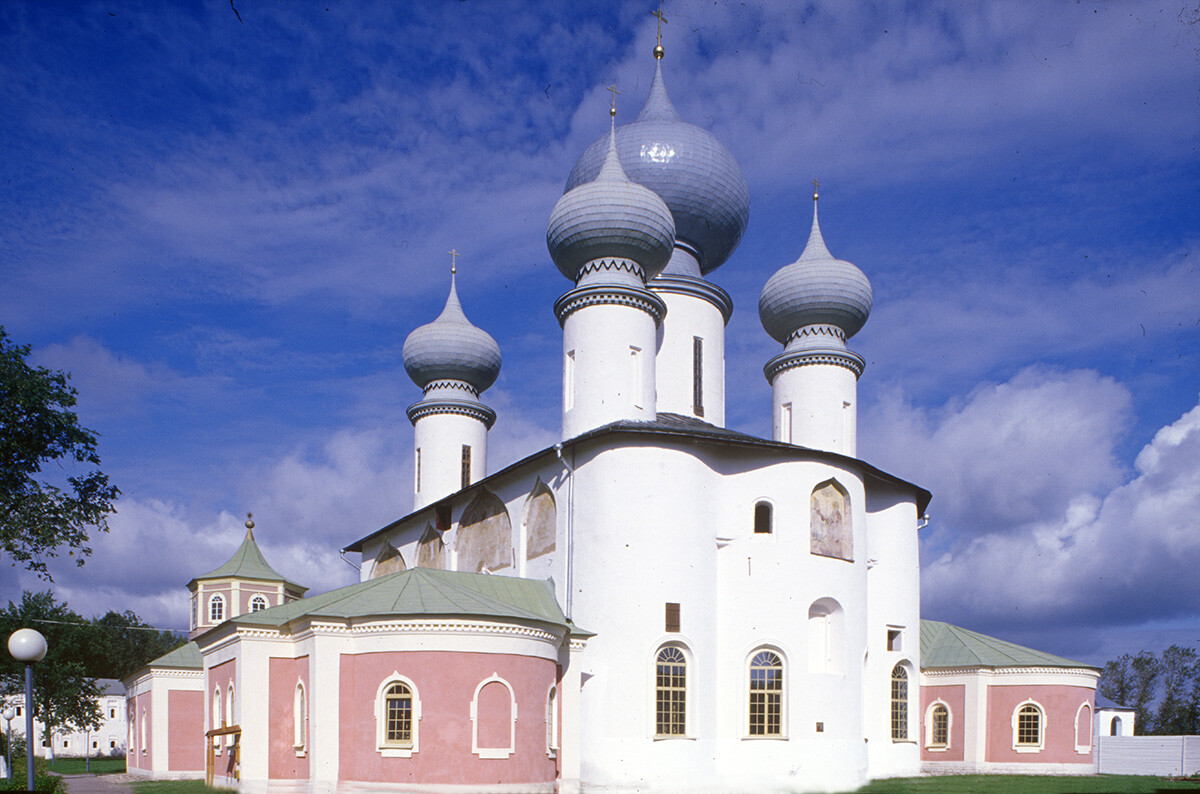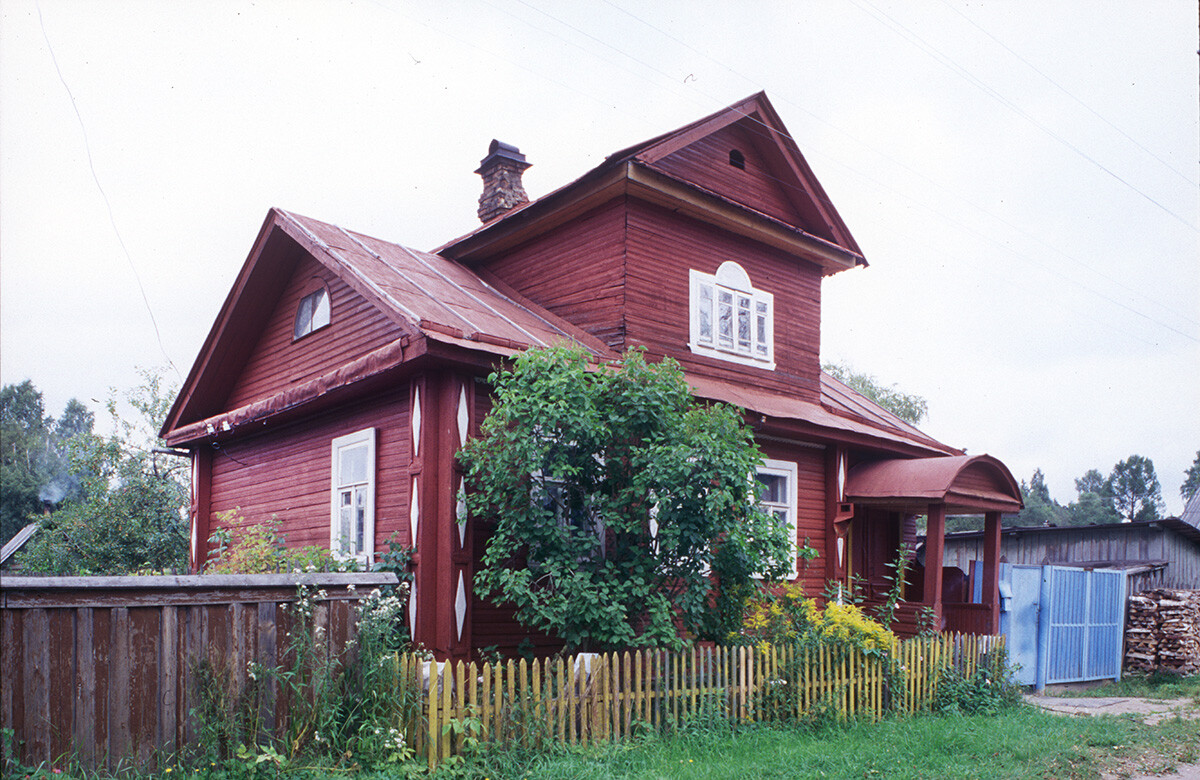Tikhvin: Native home of Nicholas Rimsky-Korsakov

 Tikhvin Mother of God-Dormition Monastery. South view across Tabor Pond. August 14, 2005
Tikhvin Mother of God-Dormition Monastery. South view across Tabor Pond. August 14, 2005
Located some 230 km to the east of St. Petersburg, the small city of Tikhvin is, today, considered within the orbit of the northern megapolis, yet it existed as a northern forest settlement centuries before the founding of Peter’s city on the Neva River. In the medieval period, it was known as the haven for one of Russia’s most revered icons. Tikhvin is also known as the birthplace of one of Russia’s most beloved great composers, Nicholas Rimsky-Korsakov, born there 180 years ago. Fortunately, the family house has been well preserved as an attractive museum.
The town name derives from the small Tikhvinka River, whose root means ‘quiet’ or ‘still’. The Tikhvinka flows in the direction of Lake Ladoga and, in the early 19th century, it formed the core of a small canal system leading to St. Petersburg.
Tikhvin’s origins
The very origins of Tikhvin are founded in a miracle. It is said that, in 1383, an icon with an image of the Virgin holding the Christ Child hovered near the Tikhvinka River. The form of the icon was one of the most ancient, the ‘Hodegetria’ (“the one who shows the way”). In this icon, the Mother of God, or Theotokos, holds the infant with one arm and points to him with the other hand. The appearance of such an ancient icon at Tikhvin was subsequently interpreted as a sign of the divine favor bestowed on Russia.
 Tikhvin Mother of God-Dormition Monastery. Cathedral of the Dormition, southeest view with attached chapels. August 14, 2005
Tikhvin Mother of God-Dormition Monastery. Cathedral of the Dormition, southeest view with attached chapels. August 14, 2005
In 1383, a log church dedicated to the Dormition of the Virgin was built for the eponymous Tikhvin image on the site of its miraculous apparition. A village, or ‘pogost’, grew around the church, which held what would become one of the most venerated icons in Russian Orthodoxy.
In more prosaic terms, the Tikhvin settlement benefited from a location on trade routes from the northeast and south that led toward the Baltic Sea via Lake Ladoga. The abundance of primitive bog iron in the nearby region of Ustiuzhna stimulated the development of metal working in numerous smithies. Until the late 15th century, such towns as Tikhvin and Ustiuzhna were controlled by the medieval commercial center of Novgorod, which created the economic system for trade in the Russian north.
Orthodox importance & the impervious Tikhvin icon
 Cathedral of the Dormition. Interior, view east toward icon screen. August 14, 2005
Cathedral of the Dormition. Interior, view east toward icon screen. August 14, 2005
The Dormition Church remained the center of the Tikhvin settlement. The wooden church was more than once destroyed by fire, yet the miraculous icon survived. And with the subjugation of Novgorod by Moscow’s Grand Prince Ivan III, Moscow became the protector of the most sacred Tikhvin Icon.
When the Dormition Church burned down again in 1500, Grand Prince Basil III (son of Ivan III) gave funds in 1507 to rebuild the Dormition Church as a greatly enlarged masonry cathedral to protect the icon. Erected in 1510-1515, under the supervision of Novgorod builder Dmitry Syrkov and with the support of Novgorod’s Archbishop Serapion, the Dormition Cathedral replicated the general form of the Dormition Cathedral in the Moscow Kremlin, with five cupolas and a large icon screen for the interior.
 Cathedral of the Dormition. Southwest pier with baldachin over Tikhvin Icon of Mother of God. August 14, 2005
Cathedral of the Dormition. Southwest pier with baldachin over Tikhvin Icon of Mother of God. August 14, 2005
The white-washed brick cathedral soared above the low, wooden structures in the rest of the Tikhin settlement. A half century later, in 1560, Basil’s son Ivan IV (the Terrible) decided to create a monastery around the cathedral. The design of the new Dormition Monastery was entrusted to Dmitry Syrkov’s son Fyodor, who resettled people living around the cathedral and cleared space for a monastic enclosure defended by a stout log wall. The monastery was intended to perform double duty as a fortification protecting the area against incursions from Sweden, north Russia’s ancient rival.
 Cathedral of the Dormition. Frescoes of Apocalypse in West Gallery. August 14, 2005
Cathedral of the Dormition. Frescoes of Apocalypse in West Gallery. August 14, 2005
The monastery’s next major brick structure was the Church of the Intercession of the Virgin, built in 1581 on the south flank of the monastery with an attached 2-story refectory and capacious dining hall that has been well preserved. Adjoining the east end of the Intercession Church is a large bell gable completed in 1600 and much modified thereafter. Partially destroyed during fighting in the Fall of 1941, the bell gable has been restored to what is thought to have been its original appearance.
‘Time of Troubles’ & a return to prosperity
 Tikhvin Mother of God-Dormition Monastery. Bell gable (right) & Refectory Church of the Intercession (1581). August 14, 2005
Tikhvin Mother of God-Dormition Monastery. Bell gable (right) & Refectory Church of the Intercession (1581). August 14, 2005
The beginning of the 17th century brought severe trials to Tikhvin. Following the death of Boris Godunov in 1605, Russia entered a period of destructive chaos known as the ‘Time of Troubles’. With no clear successor to the Muscovite throne, various warring factions, including Polish claimants, fanned the flames of a social conflagration that consumed much of European Russia.
 Tikhvin Mother of God-Dormition Monastery. Church of Tikhvin Icon of Mother of God over West Gate (late 18th century). East view. August 14, 2005
Tikhvin Mother of God-Dormition Monastery. Church of Tikhvin Icon of Mother of God over West Gate (late 18th century). East view. August 14, 2005
In 1609, attempts were made to enlist Sweden as an ally in the struggle with Poland. The alliance soon foundered and, in 1610, Sweden took advantage of the chaos to advance its commercial interests and push Russia farther from the Baltic Sea. Swedish forces led by Jacob de la Gardie seized Novgorod and then Tikhvin, but, in late May 1613, the inhabitants of Tikhvin rebelled against the Swedish garrison. When a punitive detachment returned, the townspeople barricaded themselves in the Dormition Monastery, where they withstood several assaults.
 Tikhvin Mother of God-Dormition Monastery. West (Abbot's) cloisters & Gate Church of Ascencion (1676-79). East view. August 14, 2005
Tikhvin Mother of God-Dormition Monastery. West (Abbot's) cloisters & Gate Church of Ascencion (1676-79). East view. August 14, 2005
The heroic defense of Tikhvin in 1613 prevented further erosion of Moscow’s position in the northwest. This little known Ingrian War concluded in 1617 with the Peace of Stolbovo, through which Russia regained Novgorod, but was pushed still farther from the Baltic.
 Convent of the Presentation. Bell tower & Church of Sts. Catherine & Augustus (1820). Southeast view. August 14, 2005
Convent of the Presentation. Bell tower & Church of Sts. Catherine & Augustus (1820). Southeast view. August 14, 2005
As prosperity gradually returned in the 17th century, Tikhvin and the Dormition Monastery benefited. Damaged by fires in the 1620s, the restored Dormition Cathedral gained a towering 6-level icon screen and its interior walls were newly painted with frescoes in the Yaroslavl style. Although the frescoes of the main space were repainted by Login Shustov in 1794-1797, 17th-century frescoes have remained in the attached gallery, particularly along the south side with vivid depictions of the Apocalypse.
Dormition Monastery domination & autonomy
 Cathedral of the Transfiguration (1693-1748; expanded in 1870s). Southeast view. August 14, 2005
Cathedral of the Transfiguration (1693-1748; expanded in 1870s). Southeast view. August 14, 2005
For centuries, the Tikhvin settlement was subservient to the Dormition Monastery, an arrangement that led to mounting discontent at the turn of the 18th century. Tsar Peter I (the Great) had his own reasons for restricting monastic privilege and, in 1723, Tikhvin was released from monastery governance and obligations. Fifty years later, Tikhvin was granted formal status as a town.
During the 19th century, Tikhvin experienced modest growth in trade, transportation and cottage industries. Despite damage during the German invasion, a few houses and other buildings from the period have survived in the historic center.
 Rimsky-Korsakov House-Museum. August 13, 2005
Rimsky-Korsakov House-Museum. August 13, 2005
From a cultural point of view, the most significant of these monuments is the childhood home of the composer Nikolai Rimsky-Korsakov, born in Tikhvin in March 1844. Attractively preserved as a museum overlooking the Tikhvinka River, the structure was originally built in 1801 by prominent nobleman Peter Rimsky-Korsakov, who wished to have a suitable place for balls and receptions.
 Rimsky-Korsakov House. Second drawing room, with piano of Nicholas Rimsky-Korsakov. August 13, 2005
Rimsky-Korsakov House. Second drawing room, with piano of Nicholas Rimsky-Korsakov. August 13, 2005
In 1815, the house was inherited by his son Andrey (1778-1862), who became the father of the great composer almost three decades later. The museum contains many original items related to Andrey and his wife, Sofya, and to their younger son ‘Nika’.
 Rimsky-Korsakov House. Dining room. August 13, 2005
Rimsky-Korsakov House. Dining room. August 13, 2005
Nicholas left home at the age of 12 to study at the Naval Cadet School in St. Petersburg (The Rimsky-Korsakov family had a long, distinguished record of service in the Russian navy). Nonetheless, the composer never forgot his idyllic childhood home. During his six years of study, he wrote 240 letters home and returned for visits.
 Rimsky-Korsakov House. Red drawing room. August 13, 2005
Rimsky-Korsakov House. Red drawing room. August 13, 2005
The house museum also contains a Becker piano, which the composer acquired in 1872 for his St. Petersburg residence (The Jacob Becker firm began producing pianos in St. Petersburg in 1841).
Resisting the Nazis & the return of the Tikhvin icon
 19th-century wooden house, Rimsky-Korsakov Street. August 13, 2005
19th-century wooden house, Rimsky-Korsakov Street. August 13, 2005
In the 20th century, Tikhvin shared the difficult fate of so much of Russia. As the German military juggernaut threatened Leningrad in the Fall of 1941, Tikhvin became the scene of desperate fighting.
 Volozhbensky House, Freedom Square 4. August 14, 2005
Volozhbensky House, Freedom Square 4. August 14, 2005
For the next two years, Tikhvin played a critical role in funneling supplies to the army and civilian population during epic battles to relieve Leningrad until January 1944, when Soviet forces completely lifted the almost 900-day siege.
 Early 19th-century house, Soviet Street 77. August 14, 2005
Early 19th-century house, Soviet Street 77. August 14, 2005
In this century, a momentous event in Tikhvin’s history occurred in 2004 with the return of the Tikhvin Icon to the Dormition Monastery. In the Summer of 2004, the Tikhvin Theotokos Icon was transported with great solemnity via Riga, Moscow and St. Petersburg to the Tikhvin Dormition Cathedral. After six decades, the great treasure again found its place in the monastery that has been so closely linked to Tikhvin.
 Tikhvin High School (late 19th-century wooden structure), Soviet Street 74. August 13, 2005
Tikhvin High School (late 19th-century wooden structure), Soviet Street 74. August 13, 2005
With the return of the Theotokos Icon, Tikhvin has become a major Orthodox pilgrimage center, readily accessible on a major road and rail line between St. Petersburg and Vologda. From a peak of some 72,000 in 1992, the population of Tikhvin now sits at approximately 54,000.
 Great Fatherland War memorial & soldiers' graves. 19th-century wooden house, Rimsky-Korsakov Street. August 13, 2005
Great Fatherland War memorial & soldiers' graves. 19th-century wooden house, Rimsky-Korsakov Street. August 13, 2005

